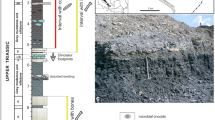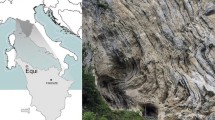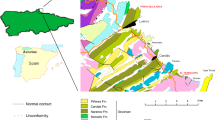Abstract
The fossil record of owls of the families Strigidae and Tytonidae in South America is poor. The aim of the present contribution is to report for the first time fossil Strigiformes from Riobamba Canton, at Chimborazo province, in Ecuador. The specimens come from a large owl burrow from Late Pleistocene beds of the Cangagua Formation. We report the finding of fossil record of Athene cunicularia and Tyto aff. T. furcata and the first fossil record of Glaucidium from Ecuador. Further, a giant species of the genus Asio is described. The specimen constitutes the largest known asionine owl, being approximately of the size of a big female of Bubo virginianus. Based on prey content at the fossil burrow, it is possible that the new Asio species predated on the other owls. If this inference is correct, it may represent the first evidence indicating intra-ordinal predation in the fossil record.
Zusammenfassung
Eulenarten (Aves, Strigiformes) des Jungpleistozäns aus Ecuador, mit Beschreibung einer neuen Art
Es gibt wenige Fossilfunde von Eulenarten der Familie Strigidae und Tytonidae in Südamerika. Das Ziel dieses Beitrags ist es, zum ersten Mal über fossile Strigiformes aus dem Kanton Riobamba der Provinz Chimborazo, Ecuador zu berichten. Die Exemplare stammen aus einer großen Eulenhöhle aus den Schichten des Jungpleistozäns der Cangahua Formation. Wir berichten über die Fossilfunde von Athene cunicularia und Tyto aff. T. furcata sowie über den ersten Fossilfund von Glaucidium in Ecuador. Weiterhin beschreiben wir eine riesige Art der Gattung Asio. Dieses Exemplar stellt die größte bekannte Eulenart dieser Gattung dar, die in etwa die Größe vergleichbar mit einem weiblichen Virginiauhu Bubo virginianus hat. Basierend auf Beutefunde aus der fossilen Höhle, lässt sich vermuten, dass sich die neue Asio-Art von anderen Eulenarten ernährte. Falls diese Folgerung richtig sein sollte, könnte dies der erste fossile Nachweis für eine Prädation innerhalb der eigenen Ordnung sein.




Similar content being viewed by others
References
Ameghino F (1891) Enumeración de las aves fósiles de la República Argentina. Rev Argent Hist Nat 1:441–453
Arredondo O (1972a) Nueva especie de ave fósil (Strigiformes: Tytonidae) del Pleistoceno superior de Cuba. Bol Soc Venez Cienc Nat 29:415–431
Arredondo O (1972b) Especie nueva de lechuza gigante (Strigiformes: Tytonidae) del Pleistoceno cubano. Bol Soc Venez Cienc Nat 30:129–140
Arredondo O (1982) Los Strigiformes fósiles del Pleistoceno Cubano. Bol Soc Venez Cienc Nat 140:33–55
Arredondo O, Olson SL (1994) A new species of owl of the genus Bubo from the Pleistocene of Cuba (Aves, Strigiformes). Proc Biol Soc Wash 107:436–444
Arredondo O (1976) The great predatory birds of the Pleistocene of Cuba. In: Olson SL (ed) Collected papers in Avian Paleontology honoring the 90th birthday of Alexander Wetmore Smithson Contrib Paleobiol, 27th edn. Smithsonian Institution Press, Washington, pp 169–187
Baumel JJ, Witmer LM (1993) Osteologia. In: Baumel JJ, King AS, Breazile JE, Evans HE, Vanden Berge JC (eds) Handbook of avian anatomy: Nomina Anatomica Avium. Nuttall Ornithological Club, Cambridge, pp 45–132
Brodkorb P (1971) Catalogue of fossil birds. Part 4 (Columbiformes through Piciformes). Bull Fla State Mus Biol Sci 15:163–266
Campbell KE (1976) The Late Pleistocene Avifauna of La Carolina, southwestern Ecuador. Smithson Contrib Paleobiol 27:155–168
Campbell KE (1979) The non-passerine Pleistocene avifauna of the Talara Tar Seeps, northwestern Peru. R Ont Mus Life Sci Contrib 118(1):203
Campbell KE Jr, Bochenski ZM (2013) Two new late Pleistocene miniature owls from Rancho La Brea, California. Acta Palaeontol Pol 58:707–721
Campbell KE Jr (2013) Revisiting Asio priscus, an extinct eared owl of the California Channel Islands. In: Göhlich UB, Kroh A (eds) Proceedings 8th international meeting of the Society of Avian Paleontology and Evolution. Paleornithological research 2013. Verlag Naturhistorisches Museum, Wien, pp 185–194
Cenizo MM (2006) Un nuevo estrígido (Strigiformes, Aves) para el Plioceno Tardío-Pleistoceno Medio de la provincia de Buenos Aires, Argentina Con algunos comentarios sobre la morfología tarsal del género Athene Boie, 1822. 9º Congreso Argentino de Paleontología y Bioestratigrafía. Academia Nacional de Ciencias, Córdoba, p 100
Cenizo MM, de Los Reyes LM (2008) Primeros registros de Tyto alba (Scopoli, 1769) (Strigiformes, Aves) en el Pleistoceno Medio-Tardío de la provincia de Buenos Aires (Argentina) y sus implicancias tafonómicas. Rev Mus Argent Cienc Nat 10:199–209
Cenizo MM, Agnolin FL, Pomi LH (2015) A new Pleistocene bird assemblage from the southern Pampas (Buenos Aires, Argentina). Palaeogeogr, Palaeoclimatol, Palaeoecol 420:65–81
Chiappe LM (1991) Fossil birds from the Miocene Pinturas Formation of southern Argentina. J Vertebr Paleontol 11:21A–22A
Dodson P, Wexlar D (1979) Taphonomic investigations of owl pellets. Paleobiology 5(3):275–284
Donázar JA (1989) Variaciones geográficas y estacionales en la alimentación del Búho Real (Bubo bubo) en Navarra. Ardeola 36(1):25–39
Enríquez PL, Eisermann K, Motta-Junior JC, Mikkola H (2015) Una revisión de la Taxonomía y Sistemática de los búhos Neotropicales. In: Enríquez PL (ed) Los Búhos Neotropicales: Diversidad y Conservación. ECOSUR, México, pp 29–38
Fergusson-Lee J, Christie DA (2001) Raptors of the world. Houghton Mifflin Company, Boston
Ford NL (1967) A systematic study of the owls based on comparative osteology. Dissertation, University of Michigan
Guérin C, Hugueney M, Mourer-Chauviré C, Faure M (1993) Paléoenvironnement Pléistocene dans l'aire archéologique de Sao Raimundo Nonato (Piaui, Brésil): apport des mammiféres et des oiseaux. Doc Lab Géol Lyon 125:187–202
Guerra C, Bover P, Alcover JA (2012) A new species of extinct little owl from the Pleistocene of Mallorca (Balearic Islands). J Ornithol 153:347–354
Hoffstetter R (1952) Les mammifères pléistocènes de la République de l’Équateur. Mém Soc Géol Fr 66:1–391
Howard H (1933) A new species of owl from the Pleistocene of Rancho La Brea, California. Condor 35:66–69
Jacobs BF, Kingston JD, Jacobs LL (1999) The origin of grass-dominated ecosystems. Ann Mo Bot Gard 86:590–643
Jones WW, Cenizo MM, Agnolin FL, Rinderknecht A, Blanco RE (2015) The largest known falconid. N Jahrb Geol Paläontol 277(3):361–372
Josse C, Cuesta F, Navarro G, Barrena V, Cabrera E, Chacón-Moreno E, Ferreira W, Peralvo M, Saito J, Tovar A (2009) Ecosistemas de los Andes del Norte y Centrales. Bolivia, Colombia, Ecuador, Perú y Venezuela. Secretaría General de la Comunidad Andina, Programa Regional ECOBONA-Intercooperation, CONDESAN-Proyecto Páramo Andino, Programa BioAndes, EcoCiencia, Nature Serve, IAvH, LTA-UNALM, ICAE-ULA, CDC-UNALM, RUMBOL SRL. Lima, Peru
König C, Weick F (2008) Owls of the World, 2nd edn. Yale University Press, New Haven
Lourenço R, Rabaça J (2006) Intraguild predation by eagle owls in Europe. Airo 16:63–68
Mikkola H (1976) Owls killing and killed by other owls and raptors in Europe. Br Birds 69:144–154
Mlíkovský J (1998) Two new owls (Aves: Strigidae) from the early Miocene of the Czech Republic, with comments on the fossil history of the subfamily Striginae. Buteo 10:5–22
Moreno Cárdenas PA, Román-Carrión JL (2017) Musarañas del género Cryptotis (Eulipotyphla: Soricidae) en el Pleistoceno Tardío de los Andes Ecuatorianos. Bol Soc Geol Mex 69(2):421–432
Mourer-Chauviré C (1987) Les Strigiformes (Aves) des Phosphorites du Quercy (France): systématique, biostratigraphie et paléobiogéographie. Doc Lab Géol Lyon 99:89–135
Nijman V, Aliabadian M (2013) DNA barcoding as a tool for elucidating species delineation in wide-ranging species as illustrated by owls (Tytonidae and Strigidae). Zool Sci 30:1005–1009
Olson SL, Hilgartner W (1982) Fossil and Subfossil Birds from the Bahamas. In: Olson SL (ed) Fossil Vertebrates from the Bahamas. Smithson Contrib Paleobiol, 48th edn. Smithsonian Institution Press, Washington, pp 22–56
Olson SL (1984) A very large enigmatic owl (Aves: Strigidae) from the late Pleistocene at Ladds, Georgia. In: Genoways HH, Dawson MR (eds) Contributions in quaternary vertebrate paleontology: a volume in memorial to John E. Guilday, vol 8. Carnegie Museum of Natural History Special Publication, pp 44–46
Olson SL (1995) The genera of owls in the Asioninae. Bull Brit Ornithol Club 115:35–39
Pardiñas UFJ (1999) Tafonomía de microvertebrados en yacimientos arquelógicos de Patagonia (Argentina). Arqueol 9:265–339
Pavia M (2008) The evolution dynamics of the Strigiformes in the Mediterranean Islands with the description of Aegolius martae n. sp. (Aves, Strigidae). Quat Int 182(1):80–89
Pavia M, Mourer-Cauviré C (2002) An overview of the genus Athene in the Pleistocene of the Mediterranean Islands, with the description of Athene trinacriae n. sp. (Aves: Strigidae). In: Zhou Z, Zhang F (eds) Proceedings of the 5th symposium of the Society of Avian Paleontology and Evolution. China Science Press, Beijing, pp 13–27
Pavia M, Manegold A, Haarhoff P (2015) Early Pliocene owls from Langebaanweg, South Africa, with first evidence of the genus Athene south of the Sahara and the description of a new species of Tyto. Acta Palaeontol Pol 60(4):815–828
Peters RH (1983) The ecological implications of body size. Cambridge University Press, Cambridge
Real J, Mañosa S (1990) Eagle Owl (Bubo bubo) predation on juvenile Bonelli’s Eagles (Hieraaetus fasciatus). J Raptor Res 24(3):69–71
Rich PV, Bohaska D (1976) The world's oldest owl: a new strigiform from the Paleocene of southwestern Colorado. In: Olson SL (ed) Collected papers in avian paleontology honoring the 90th birthday of Alexander Wetmore. Smithson Contrib Paleobiol 27:87–93
Rohner C, Doyle FI (1992) Food-stressed great horned owl kills adult goshawk: exceptional observation or community process? J Raptor Res 26(4):261–263
Sánchez MV, Genise JF, Bellosi ES, Román-Carrión JL, Cantil LF (2013) Dung beetle brood balls from Pleistocene highland palaeosols of Andean Ecuador: a reassessment of Sauer’s Coprinisphaera and their palaeoenvironments. Palaeogeogr, Palaeoclimatol, Palaeoecol 386:257–274
Sauer W (1950) Contribuciones para el Conocimiento del Cuaternario en el Ecuador. Anales Univ Central Quito 77:327–364
Serrano D (2000) Relationship between raptors and rabbits in the diet of eagle owls in southwestern Europe: competition removal or food stress? J Raptor Res 34(4):305–310
Spillmann F (1942) Contribución al conocimiento de fósiles nuevos de la avifauna Ecuatoriana en el Pleistoceno de Santa Elena. Proc Eighth Am Sci Congr 4:375–389
Suárez W, Olson SL (2015) Systematics and distribution of the giant fossil Barn owls of the West Indies (Aves: Strigiformes: Tytonidae). Zootaxa 4020(3):533–553
Tambussi C, Noriega JI (1996) Summary of the Avian fossil record from southern South America. In: Arratia G (ed) Contributions of southern South America to Vertebrate Paleontology. Müncher Geowiss Abh, 30:245–264
Tella JL, Mañosa S (1993) Eagle Owl predation on Egyptian Vulture and Northern Goshawk: possible effect of a decrease in European rabbit availability. J Raptor Res 27(2):111–112
Tonni EP (1983) Aves de un sitio arqueológico del área interserrana de la provincia de Buenos Aires. Ameghiniana 20(1–2):3–10
Tyrberg T (2008) The Late Pleistocene continental avian extinction—an evaluation of the fossil evidence. Oryctos 7:249–269
Weick F, Brown L (1980) Birds of prey of the world: a colored guide to identification of all the diurnal species order Falconiformes. Verlag Paul Parey, Hamburg
Wetmore A (1935) Pre-Columbian bird remains from Venezuela Auk 52(3):328–329
Winge H (1887) Jordfundne og nulevende Gnavere (Rodentia) fra Lagoa Santa, Minas Geraes, Brasilien. E Museo Lundii 1:1–200
Worthy TH, Holdaway RN (2002) The lost world of the moa: prehistoric life of New Zealand. Indiana University Press, Bloomington
Acknowledgements
We thank Alejandro Mesías and Pablo Lara for their help during fieldwork. We thank Edith Montalvo (Ornithology curator, EPNV) and Yolanda Davis (Ornithology curator, MACN) and Sergio Bogan (Ornithology curator, Fundación de Historia Natural Félix de Azara) for access to osteological collections under their care. We are grateful to Fernando Novas for his support during the conduction of the present study.
Author information
Authors and Affiliations
Corresponding author
Ethics declarations
Conflict of interest
The authors declare that they have no conflict of interest.
Additional information
Communicated by J. T. Lifjeld.
Publisher's Note
Springer Nature remains neutral with regard to jurisdictional claims in published maps and institutional affiliations.
Rights and permissions
About this article
Cite this article
Lo Coco, G.E., Agnolín, F.L. & Román Carrión, J.L. Late Pleistocene owls (Aves, Strigiformes) from Ecuador, with the description of a new species. J Ornithol 161, 713–721 (2020). https://doi.org/10.1007/s10336-020-01756-x
Received:
Revised:
Accepted:
Published:
Issue Date:
DOI: https://doi.org/10.1007/s10336-020-01756-x




